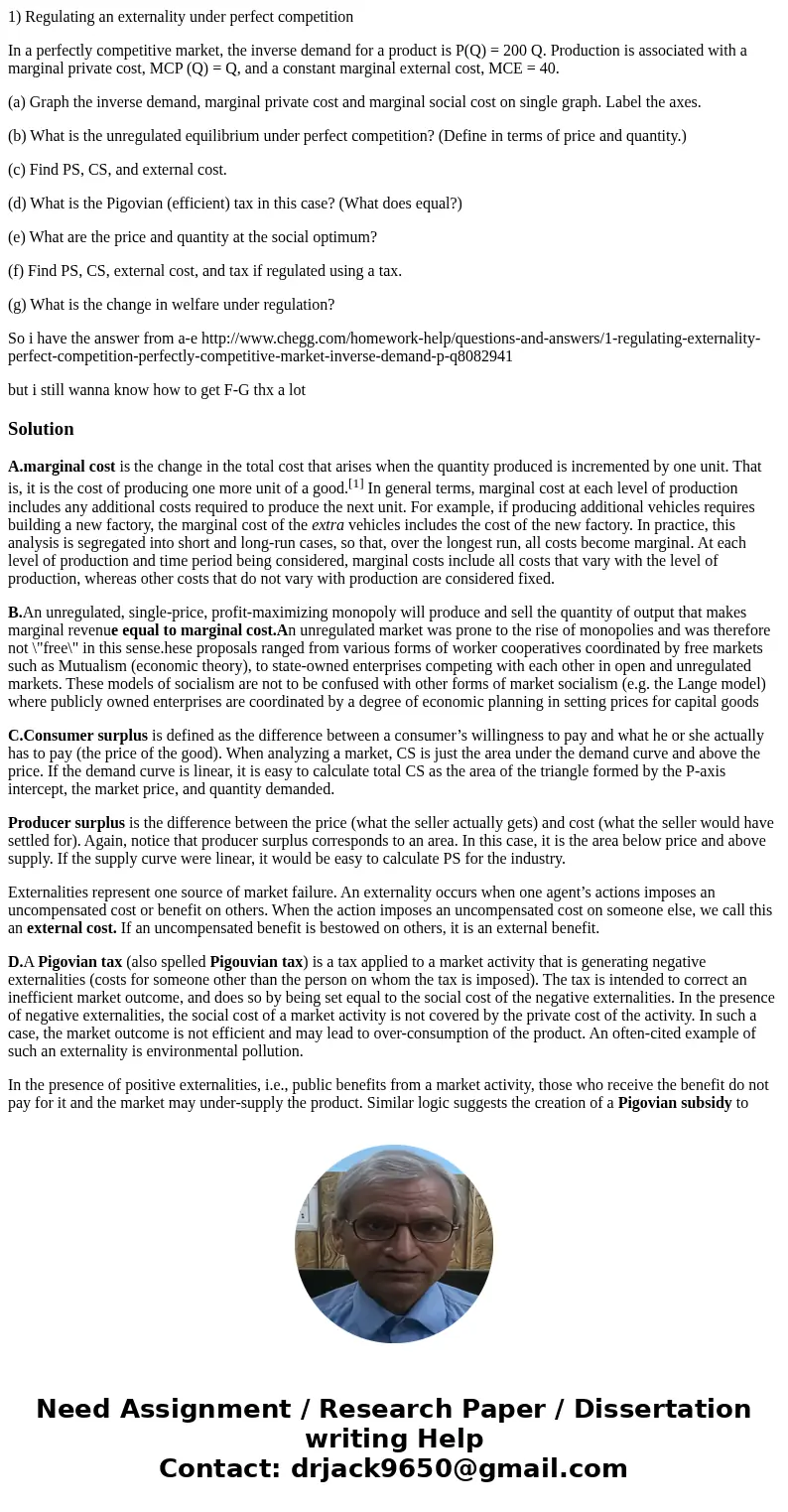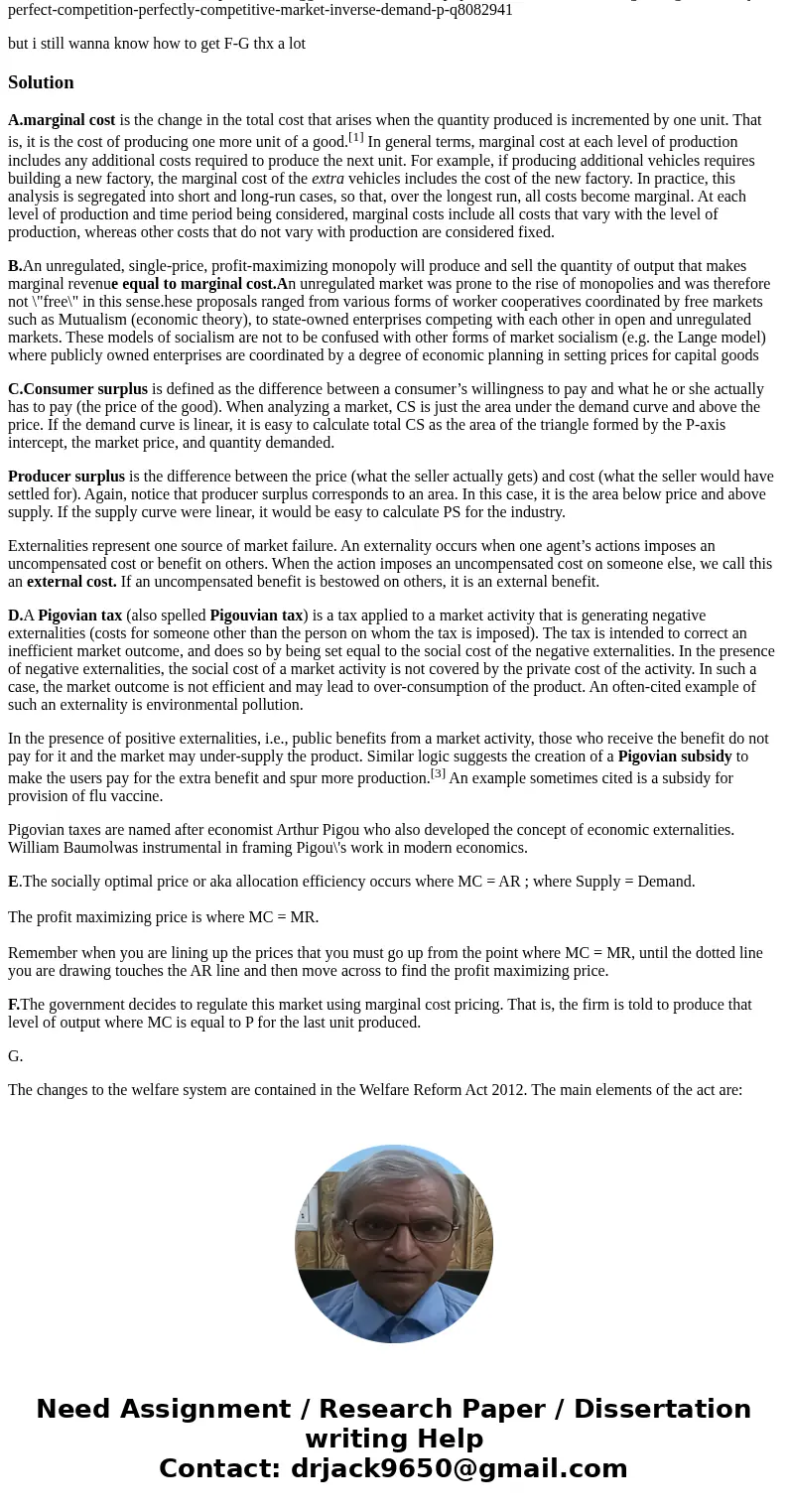1 Regulating an externality under perfect competition In a p
1) Regulating an externality under perfect competition
In a perfectly competitive market, the inverse demand for a product is P(Q) = 200 Q. Production is associated with a marginal private cost, MCP (Q) = Q, and a constant marginal external cost, MCE = 40.
(a) Graph the inverse demand, marginal private cost and marginal social cost on single graph. Label the axes.
(b) What is the unregulated equilibrium under perfect competition? (Define in terms of price and quantity.)
(c) Find PS, CS, and external cost.
(d) What is the Pigovian (efficient) tax in this case? (What does equal?)
(e) What are the price and quantity at the social optimum?
(f) Find PS, CS, external cost, and tax if regulated using a tax.
(g) What is the change in welfare under regulation?
So i have the answer from a-e http://www.chegg.com/homework-help/questions-and-answers/1-regulating-externality-perfect-competition-perfectly-competitive-market-inverse-demand-p-q8082941
but i still wanna know how to get F-G thx a lot
Solution
A.marginal cost is the change in the total cost that arises when the quantity produced is incremented by one unit. That is, it is the cost of producing one more unit of a good.[1] In general terms, marginal cost at each level of production includes any additional costs required to produce the next unit. For example, if producing additional vehicles requires building a new factory, the marginal cost of the extra vehicles includes the cost of the new factory. In practice, this analysis is segregated into short and long-run cases, so that, over the longest run, all costs become marginal. At each level of production and time period being considered, marginal costs include all costs that vary with the level of production, whereas other costs that do not vary with production are considered fixed.
B.An unregulated, single-price, profit-maximizing monopoly will produce and sell the quantity of output that makes marginal revenue equal to marginal cost.An unregulated market was prone to the rise of monopolies and was therefore not \"free\" in this sense.hese proposals ranged from various forms of worker cooperatives coordinated by free markets such as Mutualism (economic theory), to state-owned enterprises competing with each other in open and unregulated markets. These models of socialism are not to be confused with other forms of market socialism (e.g. the Lange model) where publicly owned enterprises are coordinated by a degree of economic planning in setting prices for capital goods
C.Consumer surplus is defined as the difference between a consumer’s willingness to pay and what he or she actually has to pay (the price of the good). When analyzing a market, CS is just the area under the demand curve and above the price. If the demand curve is linear, it is easy to calculate total CS as the area of the triangle formed by the P-axis intercept, the market price, and quantity demanded.
Producer surplus is the difference between the price (what the seller actually gets) and cost (what the seller would have settled for). Again, notice that producer surplus corresponds to an area. In this case, it is the area below price and above supply. If the supply curve were linear, it would be easy to calculate PS for the industry.
Externalities represent one source of market failure. An externality occurs when one agent’s actions imposes an uncompensated cost or benefit on others. When the action imposes an uncompensated cost on someone else, we call this an external cost. If an uncompensated benefit is bestowed on others, it is an external benefit.
D.A Pigovian tax (also spelled Pigouvian tax) is a tax applied to a market activity that is generating negative externalities (costs for someone other than the person on whom the tax is imposed). The tax is intended to correct an inefficient market outcome, and does so by being set equal to the social cost of the negative externalities. In the presence of negative externalities, the social cost of a market activity is not covered by the private cost of the activity. In such a case, the market outcome is not efficient and may lead to over-consumption of the product. An often-cited example of such an externality is environmental pollution.
In the presence of positive externalities, i.e., public benefits from a market activity, those who receive the benefit do not pay for it and the market may under-supply the product. Similar logic suggests the creation of a Pigovian subsidy to make the users pay for the extra benefit and spur more production.[3] An example sometimes cited is a subsidy for provision of flu vaccine.
Pigovian taxes are named after economist Arthur Pigou who also developed the concept of economic externalities. William Baumolwas instrumental in framing Pigou\'s work in modern economics.
E.The socially optimal price or aka allocation efficiency occurs where MC = AR ; where Supply = Demand.
The profit maximizing price is where MC = MR.
Remember when you are lining up the prices that you must go up from the point where MC = MR, until the dotted line you are drawing touches the AR line and then move across to find the profit maximizing price.
F.The government decides to regulate this market using marginal cost pricing. That is, the firm is told to produce that level of output where MC is equal to P for the last unit produced.
G.
The changes to the welfare system are contained in the Welfare Reform Act 2012. The main elements of the act are:


 Homework Sourse
Homework Sourse